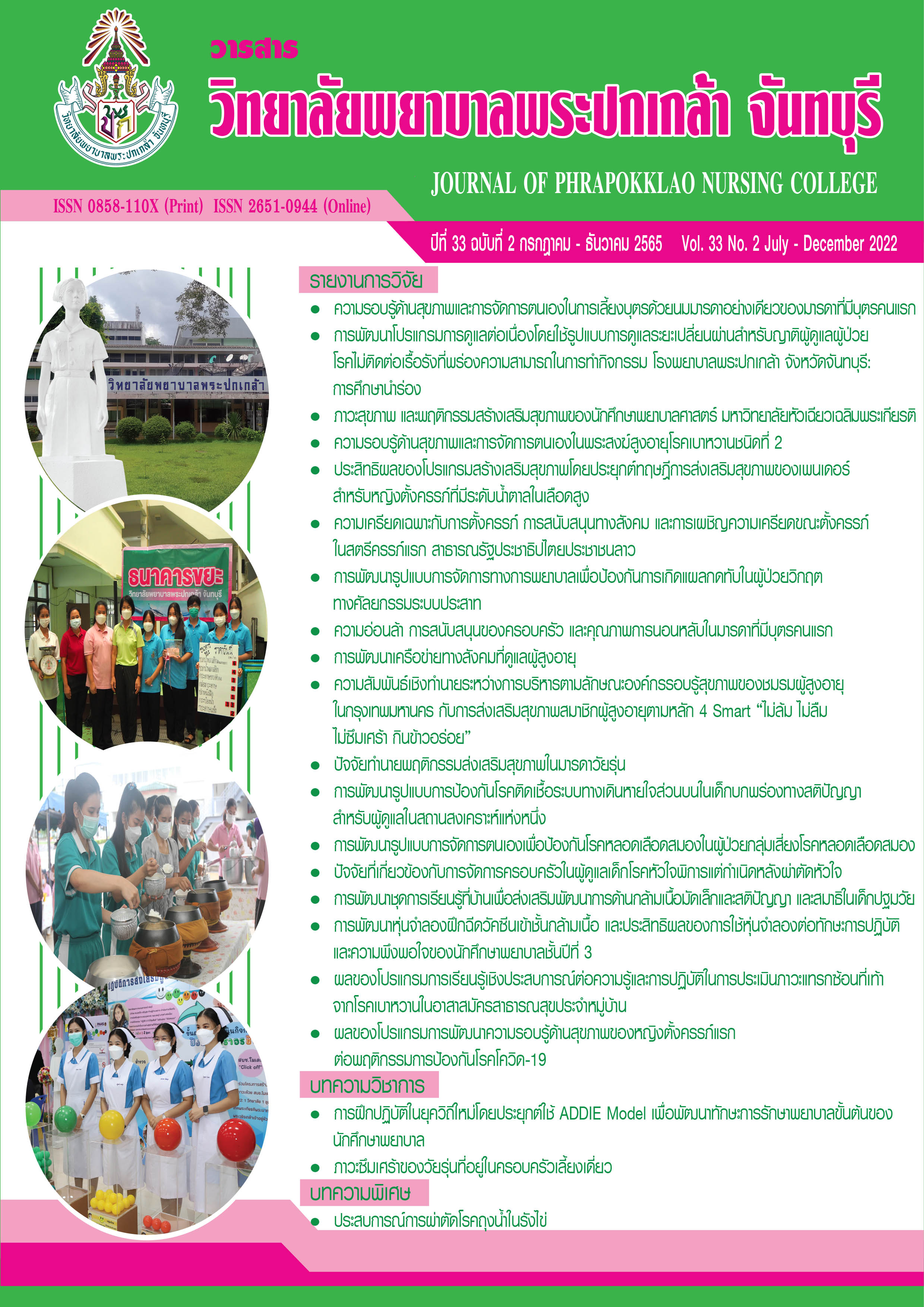The Development of an Upper Respiratory Tract Infection Prevention Model for Children with Intellectual Developmental Disorder among Caregivers in a Shelter
Keywords:
Development of a model, Prevention, Upper respiratory tract infection, Caregivers, Children with intellectual developmental disorderAbstract
This technical action research aimed to develop and study the effect of an upper respiratory tract infection prevention model for children with intellectual developmental disorder among caregivers in a shelter. The samples were three chief officers and 21 caregivers. The research instruments consisted of an upper respiratory tract infection prevention temporary model for children with intellectual developmental disorder among caregivers in a shelter, a caregiver personal data record form, an upper respiratory tract infection preventive behavior assessment form with reliability of .77, a behavior observation record form, and an occurrence of upper respiratory tract infection record form. The implementation and data collection were conducted from November, 2019 to July, 2020. Data were analyzed using frequency, percentage, mean, standard deviation, and paired t-test.
The research results revealed that 1) the upper respiratory tract infection prevention model consisted of (1) the establishment of policy to control and prevent upper respiratory tract infection, and (2) regulation of upper respiratory tract infection prevention; 2) after the development of a model, caregivers had statistically significantly higher mean score of upper respiratory tract infection preventive behavior than that of before the development of a model (t = 32.340, p < .001); and 3) after the development of a model, the occurrence of upper respiratory tract infection was lower than that of before the development of a model.
This research suggests that the chief officers should establish the appropriate policies of upper respiratory tract infection prevention for children with intellectual developmental disorder among caregivers in a shelter as well as promote upper respiratory tract infection preventive behavior.
References
กระทรวงแรงงาน. (2561). การจัดตั้งศูนย์เลี้ยงเด็กในสถานประกอบกิจการและชุมชนภายใต้การบูรณาการความร่วมมือกับ 5 กระทรวง. สืบค้นจาก http://www.mol.go.th/employee/center_children
ฆนรส อภิญญาลังกร, วราภรณ์ ผาทอง, และรัตนาภรณ์ ภุมรินทร์. (2559). ประสิทธิผลการใช้แนวปฏิบัติทางคลินิกสำหรับการจัดการทางเดินหายใจในผู้ป่วยเด็กโรคปอดอักเสบ. วารสารวิทยาลัยพยาบาลพระปกเกล้า จันทบุรี, 27(เพิ่มเติม 1), 139–151.
งานพยาบาล สถานคุ้มครองและพัฒนาคนพิการบ้านราชาวดี (ชาย) จังหวัดนนทบุรี. (2562). ข้อมูลการเจ็บป่วยของเด็ก: สมุดบันทึกการเจ็บป่วย. นนทบุรี: ผู้แต่ง.
จิรสุดา ทะเรรัมย์. (2560). ผลของโปรแกรมการเสริมสร้างแรงจูงใจต่อพฤติกรรมการจัดการตนเองของผู้ป่วยโรคหืดวัยผู้ใหญ่ (วิทยานิพนธ์ปริญญามหาบัณฑิต). กรุงเทพฯ: จุฬาลงกรณ์มหาวิทยาลัย.
จุฑาทิพย์ นามม่อง, ณัชนันท์ ชีวานนท์, และจินตนา วัชรสินธุ์. (2562). ผลของโปรแกรมส่งเสริมการรับรู้สมรรถนะแห่งตนต่อพฤติกรรมของมารดา ในการดูแลบุตรวัยหัดเดินที่ติดเชื้อทางเดินหายใจส่วนล่างเฉียบพลัน. วารสารคณะพยาบาลศาสตร์ มหาวิทยาลัยบูรพา, 27(3), 43–53.
จุไรรัตน์ กีบาง. (2562). ผลของโปรแกรมการมีส่วนร่วมและพัฒนาความสามารถผู้ปกครองในการล้างจมูกเด็กต่อพฤติกรรมการดูแลเด็กก่อนวัยเรียนโรคภูมิแพ้ทางเดินหายใจของผู้ปกครอง. วารสารพยาบาลทหารบก, 20(1), 236–244.
จุฬาลักษณ์ แก้วสุก, ยุนี พงศ์จตุรวิทย์, และนุจรี ไชยมงคล. (2559). ปัจจัยที่มีความสัมพันธ์กับพฤติกรรมของมารดาในการป้องกันโรคติดเชื้อเฉียบพลันระบบหายใจในเด็กวัยก่อนเรียน. วารสารคณะพยาบาลศาสตร์ มหาวิทยาลัยบูรพา, 24(4), 54–64.
ทิพย์ภารัตน์ ไชยชนะแสง, อัจฉรา วริลุน, อุมาสมร หังสพฤกษ์, เอมอร ทาระคำ, และภัณฑิรา คำหล่อ. (2562). ผลของโปรแกรมการสอนแนะต่อพฤติกรรมการดูแลของผู้ดูแลผู้ป่วยเด็กโรคปอดอักเสบ อายุ 1–2 ปีที่เข้ารับการรักษาในโรงพยาบาล. วารสารการพยาบาลและการดูแลสุขภาพ, 37(4), 206–215.
ภาวิณี ช่วยแท่น, ภรณี วัฒนสมบูรณ์, และสุปรียา ตันสกุล. (2563). ผลของโปรแกรมสุขศึกษาเพื่อส่งเสริมพฤติกรรมป้องกันการกลับมารักษาซ้ำในมารดาเด็กโรคปอดอักเสบ. วารสารสุขศึกษา, 43(1), 12–24.
ไมลา อิสสระสงคราม, ทัศนีย์ บุญประคอง, และเกษม จันทร์แก้ว. (2559). ผลของโปรแกรมการอบรมเพื่อพัฒนาความรู้และการปฏิบัติในการป้องกันและควบคุมโรคติดต่อของอาสาสมัครผู้ดูแลเด็กในศูนย์พัฒนาเด็กก่อนวัยเรียน กรุงเทพมหานคร. วารสารสำนักงานป้องกันควบคุมโรคที่ 7 จังหวัดขอนแก่น, 23(1), 11–21.
รุ้งกาญจน์ ออมสิน, และปรีย์กมล รัชนกุล. (2553). การพัฒนาแนวปฎิบัติสำหรับผู้ดูแลเพื่อลดอัตราการติดเชื้อระบบทางเดินหายใจในเด็กปฐมวัย ในสถานเลี้ยงเด็กกลางวัน. วารสารพยาบาลสภากาชาดไทย, 3(1–3), 44–58.
สถาบันราชานุกูล. (2559). ผลงานพัฒนาคุณภาพ ปี 2559 หอผู้ป่วย ID และคณะกรรมการป้องกันและควบคุมการติดเชื้อ. สืบค้นจาก https://th.rajanukul.go.th/_admin/file-download/5-5589-1470298818.pdf
สำนักงานส่งเสริมสวัสดิภาพและพิทักษ์เด็ก เยาวชน ผู้ด้อยโอกาส และผู้สูงอายุ. (2555). มาตรฐานศูนย์เด็กเล็กแห่งชาติ: คู่มือการดำเนินงานตามมาตรฐาน (พิมพ์ครั้งที่ 2). กรุงเทพฯ: โรงพิมพ์ชุมนุมสหกรณ์การเกษตรแห่งประเทศไทย.
สำนักโรคติดต่อทั่วไป กรมควบคุมโรค. (2554). คู่มือการประเมินศูนย์เด็กเล็กปลอดโรค. กรุงเทพฯ: โรงพิมพ์ชุมนุมสหกรณ์การเกษตรแห่งประเทศไทย.
Becker, M. H. (1974). The Health Belief Model and sick role behavior. In M. H. Becker (Ed.), The Health Belief Model and personal health behavior (pp. 82–92). Thorofare, NJ: Charles B. Slack.
Greenwood, D. J., & Levin, M. (1998). Introduction to action research: Social research for social change. Thousand Oaks, CA: Sage.
World Health Organization. (2018). Global health estimates 2016: Estimated deaths by age, sex, and cause. Retrieved from http://www.who.int/healthinfo/global_burden_disease/en/
Downloads
Published
How to Cite
Issue
Section
License
Copyright (c) 2022 JOURNAL OF PHRAPOKKLAO NURSING COLLEGE

This work is licensed under a Creative Commons Attribution-NonCommercial-NoDerivatives 4.0 International License.
เนื้อความ ข้อมูล และรายการอ้างอิงที่ผู้เขียนใช้ในการเขียนบทความเพื่อลงตีพิมพ์ในวารสารวิทยาลัยพยาบาลพระปกเกล้า จันทบุรี ถือเป็นความคิดเห็นและความรับผิดชอบของผู้เขียน คณะผู้จัดทำวารสารไม่จำเป็นต้องเห็นพ้องด้วยหรือร่วมรับผิดชอบ
บทความที่ได้รับการลงตีพิมพ์ในวารสารวิทยาลัยพยาบาลพระปกเกล้า จันทบุรี ถือเป็นลิขสิทธิ์ของวารสารวิทยาลัยพยาบาลพระปกเกล้า จันทบุรี หากหน่วยงานหรือบุคคลใดต้องการนำส่วนหนึ่งหรือทั้งหมดของบทความไปเผยแพร่ต่อเพื่อวัตถุประสงค์ใด ๆ จะต้องได้รับอนุญาตจากบรรณาธิการวารสารก่อน



